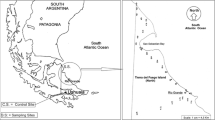Abstract
The region of Lisbon and south of Lisbon (Sado estuary) is densely industrialized, and, therefore, air pollution should be studied in a more detailed scale there. The topography of the Sado estuary region and the predominant wind direction from the northwest contribute to the influence in this region of the industries located in the north. The region selected includes a fuel-fired power station. Transplants of the lichenParmelia sulcata Taylor were suspended in nylon bags within a rectangle 15 km wide and 25 km long on a grid 2.5 km × 2.5 km, centered in the power station. In each of the 47 sites, 2 sets of 4 transplants each were hung. Care was taken (1) in covering the two sets with a polyethylene roof to prevent leaching of elements in the lichen, (2) in building a hanging system that could rotate according to the wind direction, and (3) in orienting one set toward the wind and the other set opposite the wind. For a 1-yr period and every 3 mo, one transplant of each set is collected. In this work, the results of the first campaign (after 3 mo suspension) obtained by instrumental neutron activation analysis and proton-induced X-ray emission are shown. Some elemental contents are mapped and discussed.
Similar content being viewed by others
References
M. C. Freitas, M. A. Reis, L. C. Alves, H. Th. Wolterbeek, T. Verdurg, and M. A. Gouveia, Monitoring of traceelement air pollution in Portugal: qualitative survey,J. Radioanal. Nucl. Chem. 217(1), 21–30 (1997).
M. C. Freitas and A. S. Nobre, Bioaccumulation of heavy metals usingParmelia sulcata andParmelia caperata for air pollution studies,J. Radioanal. Nucl. Chem. 217(1), 17–20 (1997).
M. A. Reis, L. C. Alves, H. Th. Wolterbeek, T. Verdurg, M. C. Freitas, and M. A. Gouveia, Main atmospheric heavy metal sources in Portugal by biomonitor analysis,Nucl. Instrum. Methods Phys. Res. B109/110, 493–497 (1996).
M. C. Freitas, M. A. Reis, L. C. Alves, H. Th. Wolterbeek, T. Verdurg, and M. A. Gouveia, Elemental accumulation in lichen transplants in the neighbourhood of thermal power stations.ANST/Nucl. Methods Environ. Res. 74, 117–118 (1996).
S. F. Stone, M. C. Freitas, R. M. Parr, and R. Zeisler, Elemental characterization of a candidate lichen research material—IAEA 336.Fresenius J. Anal. Chem. 352, 227–231 (1995).
J. O. Nriagu, Natural versus anthropogenic emissions of trace metals to the atmosphere, inControl and Fate of Atmospheric Trace Metals, J. M. Pacyna and B. Offar, eds., NATO ASI Series, Kluwer Academic (1989).
M. C. Freitas, M. A. Reis, L. C. Alves, and H. Th. Wolterbeek, Response of lichenParmelia sulcata to environmental pollutants in Portugal,Environ. Pollut. 106, 229–235 (1999).
Author information
Authors and Affiliations
Rights and permissions
About this article
Cite this article
Reis, M.A., Freitas, M.C., Alves, L.C. et al. Environmental assessment in an industrial area of Portugal. Biol Trace Elem Res 71, 273–280 (1999). https://doi.org/10.1007/BF02784213
Issue Date:
DOI: https://doi.org/10.1007/BF02784213




